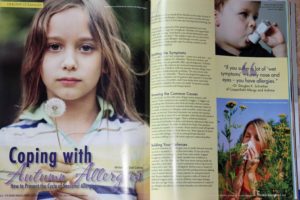 “Twenty to thirty percent of the general population has some allergy problems,” says Douglas K. Schreiber, M.D. of Copperfield Allergy & Asthma. “And there’s a lot of bad information and home remedies out there.” The number takes into account food, seasonal, and topical allergies. And though over-the-counter medications help people cope, he advised caution in self-diagnosis and treatment.
“Twenty to thirty percent of the general population has some allergy problems,” says Douglas K. Schreiber, M.D. of Copperfield Allergy & Asthma. “And there’s a lot of bad information and home remedies out there.” The number takes into account food, seasonal, and topical allergies. And though over-the-counter medications help people cope, he advised caution in self-diagnosis and treatment.
Spotting the Symptoms
“If you suffer a lot of ‘wet symptoms’ – runny nose and eyes – you have allergies,” explains Dr. Schreiber. “Based on a history and physical exam, we can generally offer a good diagnosis.” If family members suffer, the chances are increased exponentially that you’ll suffer too. Children with two parents who are allergic have a seventy-percent chance of inheriting the problem. “No one is born with allergies,” says Dr. Schreiber. “They’re developed throughout our lives and run in families, but it’s genetics plus exposure. If you feel bad on crisp days, it’s pollen, and if you notice post-nasal drip and headache related to the rains, it’s mold.” In autumn, we generally react to weeds and fungus spores.
Knowing the Common Causes
So, what brings on the itchy eyes, drippy noses, sneezes, and wheezes? The symptoms are caused by triggers. A trigger can be anything that threatens and alerts our body’s defense system. An allergy is the abnormal response from our immune system to a harmless substance or allergen such as pollen, mold, latex, pet dander, or seafood. Repeated exposures worsen that reaction. When the body is exposed to an allergen, white blood cells produce antibodies specific to the trigger. This is called sensitization. It’s the job of antibodies to detect and destroy substances that cause disease and sickness. In order to defend the body, they produce histamines to counter the invasion. Noses swell to ward off harmful invaders and eyes water to flush them out. Three quarters of those who react with allergic rhinitis to spring blooms also find themselves in the perennial category and also find themselves sniffling in the fall when ragweed scatters its pollen.
Building Your Defenses
The initial response to an allergen may be mild, but each time the exposure is repeated, the reaction intensifies. If you carry this predisposition to sensitivity, your body adds similar triggers throughout a lifetime. “The most valuable line of defense is avoidance,” says Dr. Schreiber. That may mean staying inside on high pollen count days. “The most unpopular advice I give is not to sleep with a fan.” Drugstore shelves carry a variety of products that counter symptoms, but this predisposition to adding a host of sensitivities drives patients to seek generalized relief. Recent studies have shown a greater, reduced history of additional triggers and asthma in children who began therapy at age three versus five years of age. Allergies also lead to more sinusitis and ear infections or sick days.
Treating with Immunotherapy
Many who suffer from allergies seek immunotherapy to cure their sniffles. Testing is done with a skin prick or blood test to determine triggers, and then, de-sensitization through immunotherapy can begin. The process has been around for 70 years, and like most medical practices, has improved over the course. “The extracts are better, stronger,” says Dr. Schreiber. “Immunotherapy works exceptionally well, and shots are the slam-dunk winner.”
There is a growing contest between shots and drops. The latter can be self-administered, but Dr. Schreiber warns patients to look at the whole picture. “No placebo test has been done in Europe on drops, and it’s not FDA-approved in the US. There is no board-certified doctor offering SLIT (sub-linguinal immunotherapy) in Houston,” he says. It’s more expensive too. To produce results, SLIT requires a higher volume of extract. “Fifty percent of them (drop patients) will receive benefit in the first two years of use while 80-85% (of shot therapy patients’) symptoms are controlled with decreased medication in nine months to a year.” Drops are a daily regimen, while shot therapy patients need only once monthly maintenance doses after six months. Side effects are minimal for both therapies with only slightly higher numbers from shots. But to be safe, patients are observed afterward.

